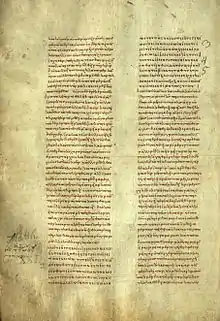Codex Monacensis
Codex Monacensis designated by X or 033 (in the Gregory-Aland numbering), A3 (von Soden), is a Greek uncial manuscript of the Gospels, dated palaeographically to the 9th or 10th century. The manuscript is lacunose.[1]
- "Codex Monacensis" may refer to any manuscript held by the Bavarian State Library.
| New Testament manuscript | |
 Folio 148 verso | |
| Name | Monacensis |
|---|---|
| Sign | X |
| Text | Gospels |
| Date | 9th/10th century |
| Script | Greek |
| Now at | Munich University Library |
| Size | 37.5 cm by 25.5 cm |
| Type | Byzantine text-type |
| Category | V |
Contents
- Gospel of Matthew 6:6, 10, 11, 7:1-9:20, 9:34-11:24, 12:9-16:28, 17:14-18:25, 19:22-21:13, 21:28-22:22, 23:27-24:2, 24:23-35, 25:1-30, 26:69-27:12,
- Gospel of John 1:1-3:8, 4:6-5:42, 7:1-13:5, 13:20-15:25, 16:23-end,
- Gospel of Luke 1:1-37, 2:19-3:38, 4:21-10:37, 11:1-18:43, 20:46-end,
- Gospel of Mark 6:46-end.[2]
Mark 14-16 is illegible.
Description
The codex was written on 160 thick parchment leaves (37.5 cm by 25.5 cm), however has survived in a fragmentary condition. The text was written in two columns, 45 lines per page,[1] in small, upright uncial letters, by a "very elegant" hand[3] with breathing marks, accents and some compressed letters. The codex contains portions of the four Gospels in the order of: John, Luke, Mark and Matthew, though the original order was Matthew, John, Luke and Mark, named the "Western Order". According to Gregory, "The bookbinder messed everything up".[2]
The text of the Gospels contains a patristic commentary (except Mark) written in minuscule letters.[2]
There are no divisions such as τίτλοι (titles), and the Ammonian sections and Eusebian Canons are absent. The texts of Matthew 16:2b–3 and John 7:53-8:11 are omitted.[2] Mark has the longer ending, but the word γάρ is missing at the end of Mk 16,8.
Text
The Greek text of this codex is a representative of the Byzantine text-type, with occasional readings deemed to be from the Alexandrian text-type. Aland gave it profile 1051, 381/2, 12, 11S and placed it in Category V.[1]
In Mark 9:49 it has the textual variant πας γαρ πυρι αλι αλισθησεται instead of πας γαρ πυρι αλισθησεται.[4]
History
The codex was held in Innsbruck in 1757. It has been in Rome, Ingolstadt (as a present from Gerard Vossius (1577–1649)), and in 1827 arrived in Munich.[2] Now the codex is located in the Munich University Library (fol. 30) in Munich.[1][5]
The codex was examined by Joseph Dobrovsky, who collated some of its readings for Johann Jakob Griesbach. Scholz collated it again, but wasn't a good collation. Tischendorf collated its text in 1844 and Tregelles in 1846. Burgon examined the manuscript in 1872.[2]
References
- Aland, Kurt; Aland, Barbara (1995). The Text of the New Testament: An Introduction to the Critical Editions and to the Theory and Practice of Modern Textual Criticism. Erroll F. Rhodes (trans.). Grand Rapids: William B. Eerdmans Publishing Company. p. 113. ISBN 978-0-8028-4098-1.
- Gregory, Caspar René (1900). Textkritik des Neuen Testaments. 1. Leipzig: J.C. Hinrichs’sche Buchhandlung. pp. 82–83.
- Scrivener, Frederick Henry Ambrose; Edward Miller (1894). A Plain Introduction to the Criticism of the New Testament. 1 (4 ed.). London: George Bell & Sons. p. 152.
- NA26, p. 121.
- "Liste Handschriften". Münster: Institute for New Testament Textual Research. Retrieved 16 March 2013.
Further reading
- Bruce M. Metzger, The Text of the New Testament: Its Transmission, Corruption and Restoration, Oxford University Press, 1968.
- H. J. Vogels, Codicum Novi Testamenti specimina (Bonn, 1929), 10
External links
| Wikimedia Commons has media related to Codex Monacensis. |
- R. Waltz, Codex Monacensis X (033): at the Encyclopedia of Textual Criticism.
- Images of the manuscript online at the CSNTM.
- Cim. 16 (= 2° Cod. ms. 30): Full digital copy at Ludwig Maximillians Universitat Muchen Open Access University Library.